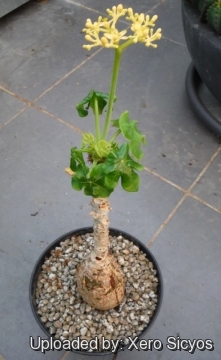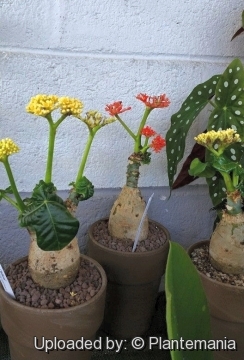




Your support is critical to our success.
Accepted Scientific Name: Jatropha podagrica cv. Yellow Flowers

Origin and Habitat: Cultivated, or mutant form, originated in Tanzania. The natural species is native to the tropical Americas Colombia, Guatemala, Honduras, Nicaragua.
Synonyms:
Jatropha podagrica Hook.
Bot. Mag. 74: t. 4376 1848
Cultivars (1):
ENGLISH: Yellow Jatropha
Description: Jatropha podagricaSN|22500]]SN|22500]] cv. Yellow Flowers (formerly sold as Jatropha podagricaSN|22500]]SN|22500]] sp. Tanzania) is an outstanding cultivar of Jatropha podagricaSN|22500]]SN|22500]] distinguished from the type species for its bright yellow flowers instead of carmine-red. All the other characteristics clearly show that they are conspecific, namely size and form of stems, leaves, flowers, fruit and seeds.
The standard Jatropha podagricaSN|22500]]SN|22500]] (Gout Stalk or Buddha belly) is a very remarkable small erect succulent with a singularly distorted stem and branches much swollen at their bases, giving it the common name. The large shallowly lobed leaves are arranged at the end of the branches. Throughout the year it produces small red-orange flowers in clusters like a coral at the tip of a long red stalk. All parts, especially the seeds, of the plant contain the toxic curcin, making it poisonous.
Subspecies, varieties, forms and cultivars of plants belonging to the Jatropha podagrica group
 Jatropha podagrica Hook.: is swollen and tuber-like (caudiciform) at the base, branches also swollen with lobed leaves on the tips. Flowers many, small, orange scarlet.
Jatropha podagrica Hook.: is swollen and tuber-like (caudiciform) at the base, branches also swollen with lobed leaves on the tips. Flowers many, small, orange scarlet. Jatropha podagrica cv. Yellow Flowers: (Jatropha podagrica sp. Tanzania) has bright yellow flowers instead of carmine-red.
Jatropha podagrica cv. Yellow Flowers: (Jatropha podagrica sp. Tanzania) has bright yellow flowers instead of carmine-red.
Bibliography: Major references and further lectures
1) Sir William Jackson Hooker, David Prain, Otto Stapf “Curtis's Botanical Magazine” Volume 74 Reeve Brothers, 74: pl. 4376.1848
2) University of California Publications in Botany 74: 1-73. 1979
3) Taxon 29: 536-537, 715-716. 1980
4) Listados Floristicos de Mexico 4: i-v, 1-246. 1986
5) Proceedings of the Indian Science Congress Association 76(3,VI): 183. 1989
6) Umberto Quattrocchi “CRC World Dictionary of Medicinal and Poisonous Plants: Common Names, Scientific Names, Eponyms, Synonyms, and Etymology” (5 Volume Set) Copertina anteriore CRC Press, 03/May/2012
7) Nasir El Bassam “Handbook of Bioenergy Crops: A Complete Reference to Species, Development and Applications” Earthscan, 2010
8) Swaddiwudhipong W, Kunasol P, Sangwanloy O, et al. “Foodborne disease outbreaks of chemical etiology in Thailand, 1981-1987.” Southeast Asian J Trop Med Public Health 20(1):125-132. 1989
9) D. Jesse Wagstaff “International Poisonous Plants Checklist: An Evidence-Based Reference” CRC Press, 07/Jul/2008
10) Gurcharan Singh Randhawa, Amitabha Mukhopadhyay “Floriculture in India” Allied Publishers, 01/Jan/1986
11) Torstar Books (Firm) “Flowering plants/2” Torstar Books, 1985
12) Hans-August Rotter “Growing plants without soil: easy-care plants for home and office” EP Pub., 28/Oct/1982
13) Nathaniel Lord Britton “Flora of Bermuda” Scribner, 1918
14) Bernice P. Bishop, "Museum Bulletin" - Bishop Museum Press, 1935
15) William C. Burger “Flora Costaricensis” Edition 36 Field Museum of Natural History, 1971
16) SIR JOHN LUBBOC BART. “SEEDLINGS” 1892
17) Werner Rauh “The Wonderful World of Succulents: Cultivation and Description of Selected Succulent Plants Other Than Cacti” Smithsonian Institution Press, 1984
18) Burkill, H.M. “The useful plants of west tropical Africa” Vol 2 1985.
19) A. Radcliffe-Smith “Flora Zambesiaca” Vol 9 Part 4 1996

Jatropha podagrica sp. Tanzania (Jatropha podagrica cv. Yellow Flowers) Photo by: Xero Sicyos

Jatropha podagrica sp. Tanzania (Jatropha podagrica cv. Yellow Flowers) Photo by: © Plantemania
Cultivation and Propagation: Jatropha podagricaSN|22500]]SN|22500]] is a very ornamental species, easy to grow and suited for any well drained soil on bright light. It can be cultivated in open air in tropical or subtropical climate zones, in full sun, or (preferably) in light shade. It is a good plants for rock gardens. It is a good shrub for the rockery. Good for pot culture it adapts well in bright windows in the home and greenhouses too. Its clean outline and simple form have a sculptural drama and can suit a stark modern interior. It looks its best in winter while it is still without leaves and has only its flowers.
J. podagrica is also known for its incredible ability to attract a variety of butterflies wherever it is grown.
Soil: The ideal potting-medium is one with good moisture-retaining capacity but open and well drained and be allowed to dry between waterings. .
Exposure: These plants don't seem to love being blasted by the sun in the summer but prefer bright light, and will therefore not make demands on your prime growing space. However shade grown plants will tend to produce fewer, and etiolated growth (weak, oft and gummy stems with unusually long internodes, and generally paler green coloration). The colour of this plant is much more marked if grown in full sun.
Watering: It is relatively flexible in its watering requirements. It needs much water when it is growing. It can be watered regularly as long as the medium is open and well drained. As with any normal plant when watering, it is best to do so thoroughly, until a little water comes out through the drain holes. Allow the medium to dry out somewhat between waterings. From autumn onwards it must be given a rest period and stop watering during the winter when it sheds the leaves.
Space plants apart to allow air movement between branches and leaves. This will help with evaporation of extra water droplets collected during watering.
Fertilization: Use fertilizer with low nitrogen and high phosphorus and potassium ratios. Feed during spring and summer and withhold feeding during winter.
Hardiness: Tender, protect from frost . Temperature spring to autumn: nocturnal at least 18°C and diurnal up to 38°C. Wintering: nocturnal 12°C and diurnal 20°C or more.
Pests and diseases: It can rot if it is cold and damp.
Propagation: Seeds/Cuttings
Warning: All the parts of the plant are considered as poisonous. When a plant get damaged it exudes a thick white milky sap known as latex. This latex is poisonous and particularly dangerous for the eyes, skin and mucous membranes. So pay extreme attention not to get any in your eyes or mouth. Cultivated plants must be handled carefully. If consumed severe nausea, vomiting, diarrhea, gastroenteritis, blindness are expected.
Medicine:Antipyretic, diuretic, purgative, antibacterial, anti-fungal, hypotensive, spasmolytic and appears to act as a nerve-blocking agent. All parts used as medicine for subsidence of swelling, to treat jaundice, gonorrhea, relieve pains and detoxify the viper bites. From the seeds a powerful purgative oil.
Traditional uses: Jatropha podagricaSN|22500]]SN|22500]] was used to tan leather and produce a vibrant red dye in Mexico and the south-western United States.
Propagation: Propagated by division or seeds.
| Your Actions | |
|---|---|
| Back to Jatropha index | |
| Back to Euphorbiaceae index | |
 |
Back to Succulents Encyclopedia index |
Privacy stantement - Terms and conditions - How to cite - About us - Feedback - Donate



